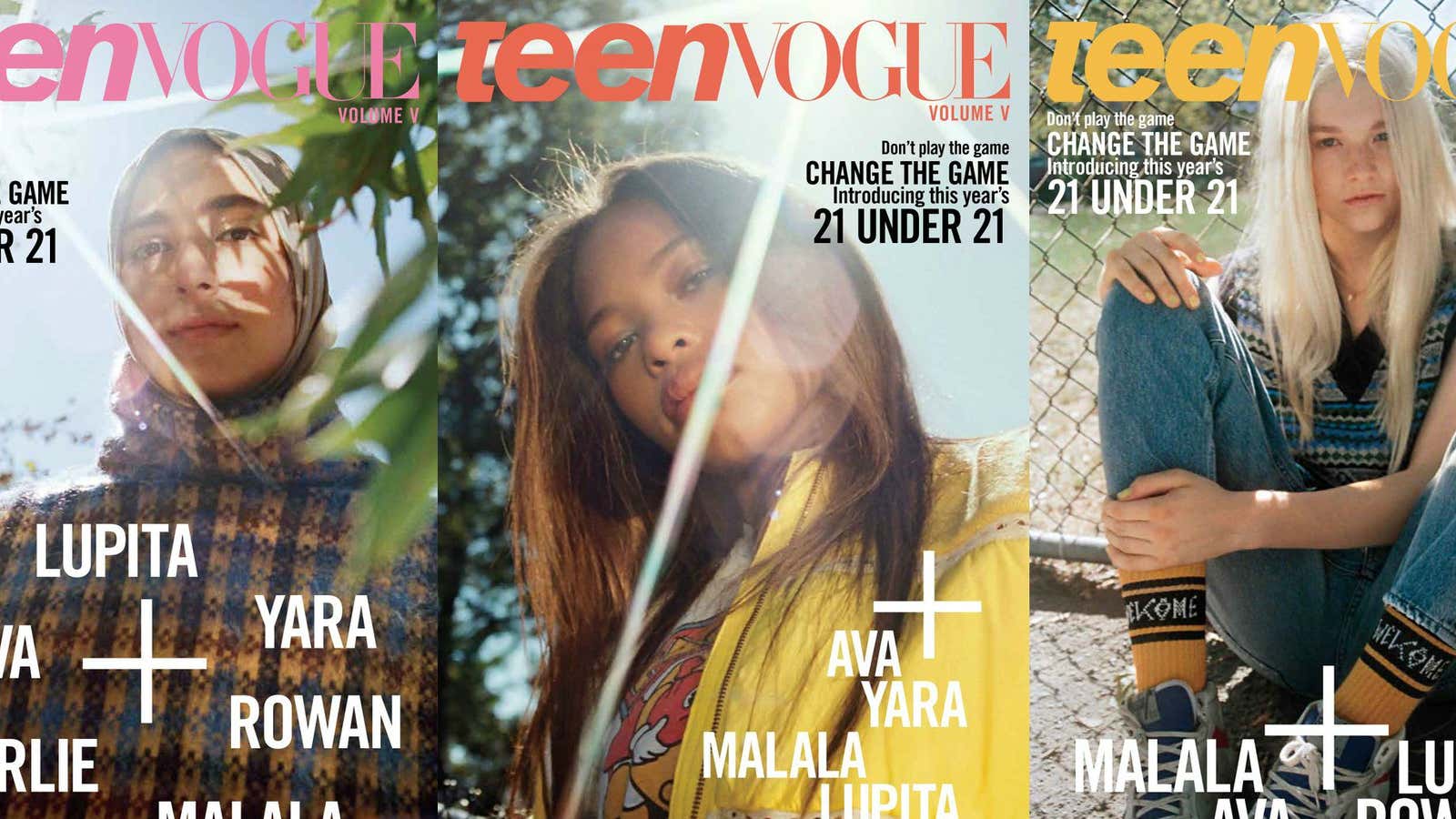In the new year, Condé Nast darling Teen Vogue will be going all-digital, but not without a final celebration of its loyal subscriber base of young women. Over the weekend, editor in chief Elaine Welteroth—only the second black editor in chief in Condé Nast history (after Keija Minor, who left Brides in August 2017)—announced that Teen Vogue subscribers would receive special issues of Teen Vogue’s final print version in their mailbox this week: “For the first time in our history, we celebrate REAL GIRLS and FEMMES (aka not celebs) on our cover who are making a difference in the world,” she wrote on Instagram. “These faces represent just a few of the young inventors, activists, artists, and athletes recognized in our annual #21Under21 list for their outstanding achievement.”
The three #21Under21 cover stars in this special collector’s edition (sponsored by Google) are 17-year-old Muslim American activist Hebh Jamal, 19-year-old Lil’ Yachty protégé rapper Kodie Shane, and 18-year-old trans femme model Hunter Schafer—all three shot by Petra Collins, a Ryan McGinley protégé and face of Gucci who has had her work exhibited at New York’s Museum of Modern Art. The other #21Under21 honorees include 14-year-old Taylor Richardson, an aspiring astronaut, 19-year-old Nadya Okamoto, a Harvard sophomore who is running for city council, and 14-year-old Anushka Naiknaware, who invented the nanotech bandage. Yousafzai wrote the introduction: “Know that when you stand up, your sisterhood around the world stands with you.”
The faces may not be household names (yet), but Teen Vogue made a safe bet by adding a cover line featuring the first names of six celebrities that Teen Vogue readers likely adore: actress Lupita (N’yongo), actress and Harvard undergraduate Yara (Shahidi), producer and director Ava (DuVernay), actress Rowan (Blanchard), supermodel and coding evangelist Karlie (Kloss), and youngest Nobel Prize laureate Malala (Yousafzai). “This issue is dedicated to the dreamers and the do-ers,” Welteroth, a role model herself to 177K Instagram followers, added.
It is a logical follow-up to the previous issue, which was guest edited by Hillary Clinton. “Teen Vogue takes teen girls seriously and understands that style and substance aren’t mutually exclusive,” the secretary of state and senator wrote in her editor’s letter. “Have you ever noticed that whenever a teenage girl takes a stand on an important issue, people seem surprised?” She, alongside Shahidi, keynoted the first-ever Teen Vogue Summit in Los Angeles in early December.
Teen magazines have a precedent of putting “real girls” on their covers while their older counterparts recycle the same over-exposed celebrities. From 2011 and 2013, Hearst-owned competitor Seventeen hosted a “Pretty Amazing” contest to find a “real girl” October cover star between ages 15 and 22. The 2012 winner was Lindsay Brown, a Notre Dame undergraduate who is currently earning her law degree and master in public policy. These covers, as thousand-watt as the smiles are, won’t fly off the newsstands the same way that a Beyoncé or Selena Gomez cover would, but they are dedicated to a loyal—and important—readership that is often condescended to in other media.
Teen Vogue’s evolution into a digital-only brand is emblematic of the fiscal upheaval now taking place throughout media. It also came after high-profile efforts to find a sustainable print model for the magazine. In 2016, Welteroth told Business of Fashion that the Teen Vogue team was “reimagining how to engage [readers] more meaningfully in print.” The magazine began printing quarterly, but the demand did not match up to the scarcity. According to the Alliance for Audited Media, the first two quarterly issues of Teen Vogue averaged 22,590 single copy sales, less than half of the number of sales from the first half of 2015. Additionally, the New York Post reported that on December 8, four Teen Vogue staffers on the print team were laid off.
It is possible that Teen Vogue, with its earnest conviction in the magic of young women, has, indeed, “successfully reimagined how to engage with their readers more meaningful in print”. What that does not necessarily translate to, unfortunately, is newsstand sales and subscriptions. (All the teens are on Instagram, anyway.) Just think: Teen Vogue’s final cover stars include three groundbreaking young women and the first U.S. presidential candidate of a major political party. That’s a major win for girls and women and clear proof that numbers don’t always tell the entire story.
